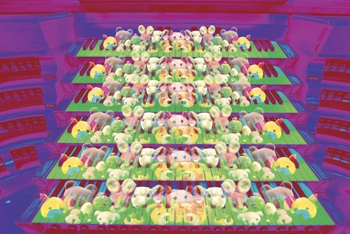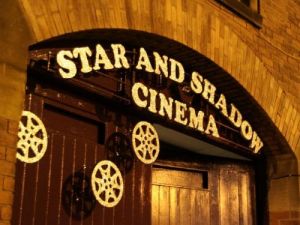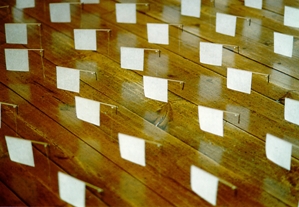theartsdesk in Newcastle: The AV Festival | reviews, news & interviews
theartsdesk in Newcastle: The AV Festival
theartsdesk in Newcastle: The AV Festival
Energy is the theme of the electronic arts festival in the North-East

At seven o'clock on a Friday night, with the first spring twilight of the year as a backdrop, Newcastle’s Civic Centre reverberated to a new composition for its Carillon bells. Mingling eerily with birdsong, it marked a rather different start to the weekend from the hoards of hen nights getting ready for a night on the Toon. This was the opening night of AV, the biennial international festival of electronic arts.
The festival chose energy as its curatorial theme. It was a snug fit for a town associated as strongly with its foundations in industry, and more recently with economic hardship and empty shop windows. Taking the plural of “electronic arts” seriously, the 10-day festival - which concludes today - has comprised exhibitions, performances, screenings, talks, club nights and symposia throughout Newcastle, Gateshead, Sunderland and Middlesbrough, all of them playing with the boundaries of the genre they’ve been put into.
 Charlemagne Palestine, a composer from New York, is one such. Aside from his new piece for the Civic Centre’s bells, he dominated the opening weekend. His exhibit beardemonium tintinnabulum formed part of the Hatton Gallery’s All Art Is, Is Rhythm (right: Beast by Charlemagne Palestine). It sets the tone for much of the work on show: video and film clips of the artist himself playing the organ, hundreds of organically arranged soft toys and flashing lights. His campanology continued in two other churches and the cathedral over the rest of the weekend, clashing with the sound of the Toon Army celebrating a 6-1 victory at St James’s Park.
Charlemagne Palestine, a composer from New York, is one such. Aside from his new piece for the Civic Centre’s bells, he dominated the opening weekend. His exhibit beardemonium tintinnabulum formed part of the Hatton Gallery’s All Art Is, Is Rhythm (right: Beast by Charlemagne Palestine). It sets the tone for much of the work on show: video and film clips of the artist himself playing the organ, hundreds of organically arranged soft toys and flashing lights. His campanology continued in two other churches and the cathedral over the rest of the weekend, clashing with the sound of the Toon Army celebrating a 6-1 victory at St James’s Park.
That first Friday night finished off at the edge of Byker Bridge, at the Star and Shadow cinema (below left). This volunteer-run warehouse-cum-cinema, located on the edge of the increasingly fashionable Ouseburn Valley, was transformed by local artists, musicians and filmmakers for the festival into a throwback to 1970s sci-fi film that none of the attendees were old enough to remember. Oiled by dubious-sounding “Space Ale”, the party set the tone for the rest of the club nights and AV Late Hub events that would pepper the festival: Berlin DJs, warehouse parties and musical collaborations.
 Newcastle’s most successful independent cinema, the Tyneside, has been another focus for the festival, although slight confusion among the staff about where in the four-storey building various events were happening sometimes suggested otherwise. You could hardly blame them. With a two-day Recycled Film symposium taking place, plus screenings and nightly “Cocktail Hour” talks in the Feral Trade café (the Festival’s daytime hub), there was almost too much for the place to deal with alongside daily blockbuster business.
Newcastle’s most successful independent cinema, the Tyneside, has been another focus for the festival, although slight confusion among the staff about where in the four-storey building various events were happening sometimes suggested otherwise. You could hardly blame them. With a two-day Recycled Film symposium taking place, plus screenings and nightly “Cocktail Hour” talks in the Feral Trade café (the Festival’s daytime hub), there was almost too much for the place to deal with alongside daily blockbuster business.
Recycled Film features a collection of filmmakers who revel in adapting and recreating found footage and archive material, with eclectic results. Home movies mingle alongside advertisements, industrial and educational films and historic newsreels back onto the silver screen. Christian Marclay’s Up and Out didn’t prove the most resting of hangover cures, midday through the first Saturday. It involved pairing Michelangelo Antonioni’s Blow Up (1966), in which David Hemmings’s photographer becomes entwined in a murder, with the soundtrack of Brian De Palma’s detective thriller Blow Out (1981). It required the audience to do as much investigative work as the protagonists in determining the plot. Surprisingly, more often than not it worked.
The importance placed on energy throughout the festival found iconic buildings from Newcastle’s industrial heritage being put into use. Behind the city’s station, the buildings associated with the city’s shipping, building and docking past have long since been appropriated as a labyrinthine maze of offices, restaurants, workshops and galleries. The Stephenson Works were once the construction site of Robert Stephenson’s locomotives. For the festival it hosted Resonator, an open workshop run by the Culture Lab’s Jamie Allen and Will Schrimshaw. In an attempt to create an “anti-show”, a broad mix of composers, researchers, artists and thinkers were brought in to discuss their work and its connection to energy.
 Local artists were welcome to join in, and by the second day the place had rapidly transformed into the messy venue of a group studio. True to Geordie form (despite the fact there’s a greater representation of racial plurality in the room than in most places in the city), everyone was ludicrously friendly, offering refreshments from a homemade bar. The aim behind Resonator was not so much the final outcome – officially a “cross-reference archive of a process of creating” – as to give the opportunity for group work, a sharing of approaches and to broaden Newcastle’s cosy community of artists.
Local artists were welcome to join in, and by the second day the place had rapidly transformed into the messy venue of a group studio. True to Geordie form (despite the fact there’s a greater representation of racial plurality in the room than in most places in the city), everyone was ludicrously friendly, offering refreshments from a homemade bar. The aim behind Resonator was not so much the final outcome – officially a “cross-reference archive of a process of creating” – as to give the opportunity for group work, a sharing of approaches and to broaden Newcastle’s cosy community of artists.
On to the Discovery Museum, where Montreal-based Artificiel were mounting a mesmerising work called Condemned Bulbes. Set within the museum’s Victorian Great Hall, completely blacked out, oversized light bulbs provide light and sound through a series of dimmers. Again, there was local relevance: the incandescent light bulb was invented by a son of Sunderland, Joseph Swan.
There was an equally powerful exhibit on the Tyne Bridge. After trekking around the Quayside’s cobbled streets and onto the bridge itself – complete with obligatory car horns – and briefly delayed by way of a couple of Geordies’ misleading directions, I made it into the North Tower (above right) and Schrimshaw’s installation, Space Against Itself. Amongst evidence of pigeon inhabitation, giant speakers played on the building’s acoustic frequencies. It certainly gave the seagulls something to think about.
 Returning to the Hatton, considerably easier to locate within the red-brick quadrangle of Newcastle University, Felix Hess’s It’s in the Air demanded a second look. By far the most beautiful of all the exhibits in the festival, the installation of 500 small paper vanes (left) made for a perfect time-waster. The delicate little flags, which occupied the floor of the gallery’s largest room, comprise Hess’s simplest work. Relying not on electricity to demonstrate the impact of energy, the flags respond to movements in the air – people walking past, or trying to provoke them more deliberately – and from one another, moving like a living organism.
Returning to the Hatton, considerably easier to locate within the red-brick quadrangle of Newcastle University, Felix Hess’s It’s in the Air demanded a second look. By far the most beautiful of all the exhibits in the festival, the installation of 500 small paper vanes (left) made for a perfect time-waster. The delicate little flags, which occupied the floor of the gallery’s largest room, comprise Hess’s simplest work. Relying not on electricity to demonstrate the impact of energy, the flags respond to movements in the air – people walking past, or trying to provoke them more deliberately – and from one another, moving like a living organism.
As much as the AV Festival has brought artists, filmmakers and composers from all over the world to investigate the theme of energy through the electronic arts, what has been just as evident from this year’s outing is the role played by the region's past. Last month local artists used the empty windows of vacated shops as an exhibition space for Viz-style cartoons mocking the economic downturn: the work has given a second life to abandoned buildings. AV has done something similar. Electronic artists have brought parts of Newcastle alive for citizens who never knew they existed, and certainly never read the surprising number of dusty blue plaques slapped on the flanks of forgotten buildings. It's possible that as many people have turned up for the spaces themselves, rather than the art created for them. On a beautiful spring afternoon these past few days, it's been possible to get lost anew in a city transformed into a gallery.
- AV Festival website
Share this article
The future of Arts Journalism
You can stop theartsdesk.com closing!
We urgently need financing to survive. Our fundraising drive has thus far raised £49,000 but we need to reach £100,000 or we will be forced to close. Please contribute here: https://gofund.me/c3f6033d
And if you can forward this information to anyone who might assist, we’d be grateful.

Subscribe to theartsdesk.com
Thank you for continuing to read our work on theartsdesk.com. For unlimited access to every article in its entirety, including our archive of more than 15,000 pieces, we're asking for £5 per month or £40 per year. We feel it's a very good deal, and hope you do too.
To take a subscription now simply click here.
And if you're looking for that extra gift for a friend or family member, why not treat them to a theartsdesk.com gift subscription?

Add comment